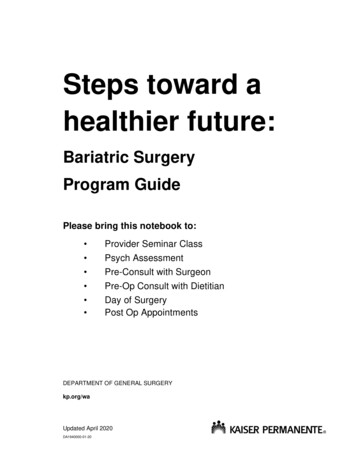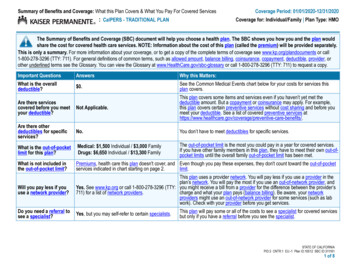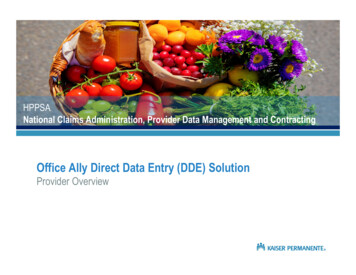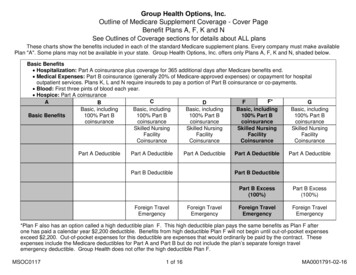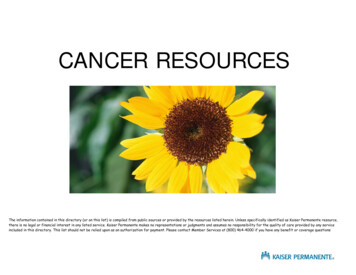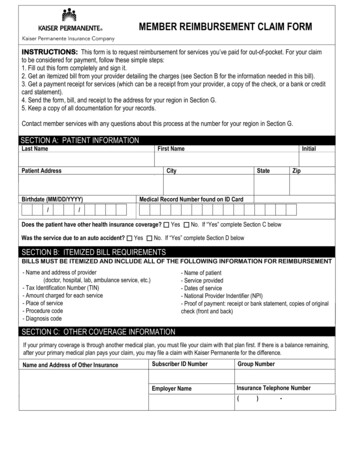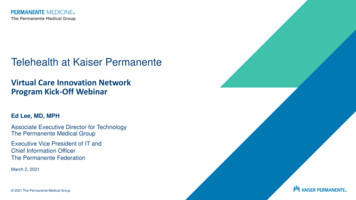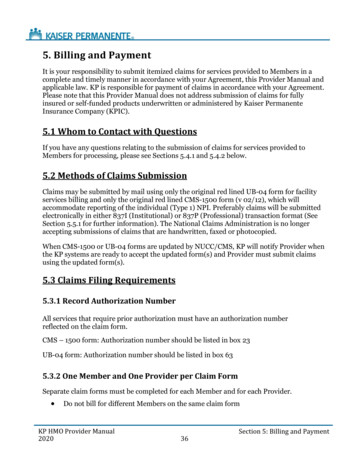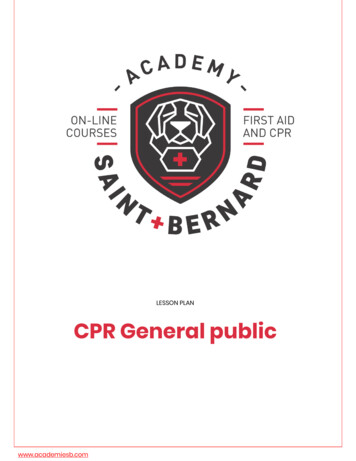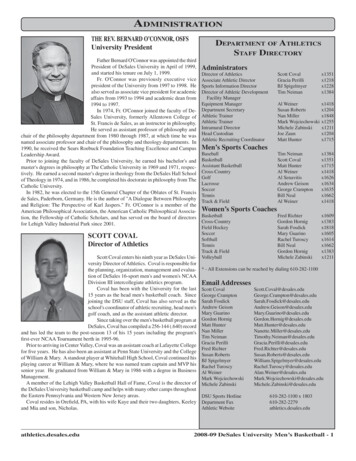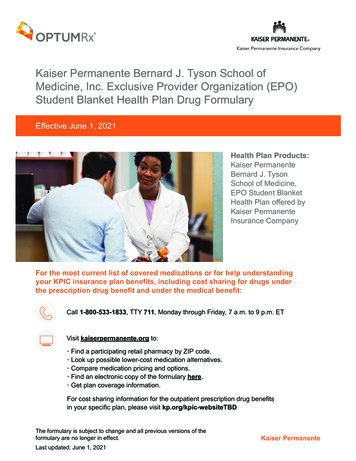
Transcription
Kaiser Permanente Bernard J. Tyson School ofMedicine, Inc. Exclusive Provider Organization (EPO)Student Blanket Health Plan Drug FormularyEffective June 1, 2021Health Plan Products:Kaiser PermanenteBernard J. TysonSchool of Medicine,EPO Student BlanketHealth Plan offered byKaiser PermanenteInsurance CompanyFor the most current list of covered medications or for help understandingyour KPIC insurance plan benefits, including cost sharing for drugs underthe prescription drug benefit and under the medical benefit:Call 1-800-533-1833, TTY 711, Monday through Friday, 7 a.m. to 9 p.m. ETVisit kaiserpermanente.org to: Find a participating retail pharmacy by ZIP code. Look up possible lower-cost medication alternatives. Compare medication pricing and options. Find an electronic copy of the formulary here. Get plan coverage information.For cost sharing information for the outpatient prescription drug benefitsin your specific plan, please visit kp.org/kpic-websiteTBDThe formulary is subject to change and all previous versions of theformulary are no longer in effect.Last updated: June 1, 2021Kaiser Permanente
Table of ContentsInformational Section.3ANTIHISTAMINE DRUGS - Drugs for Allergy.9ANTI-INFECTIVE AGENTS - Drugs for Infections. 11ANTINEOPLASTIC AGENTS - Drugs for Cancer. 30ANTITOXINS,IMMUNE GLOB,TOXOIDS,VACCINES - DRUGS FOR THE IMMUNE SYSTEM. 45AUTONOMIC DRUGS - Drugs for the Nervous System. 52BLOOD FORMATION, COAGULATION, THROMBOSIS - Drugs for the Blood.65CARDIOVASCULAR DRUGS - Drugs for the Heart. 78CELLULAR AND GENE THERAPY - Drugs for Cancer. 117CENTRAL NERVOUS SYSTEM AGENTS - Drugs for the Nervous System. 117DEVICES - Medical Supplies and Durable Medical Equipment. 160DIAGNOSTIC AGENTS. 167DISINFECTANTS (FOR NON-DERMATOLOGIC USE) - Disinfectants. 173ELECTROLYTIC, CALORIC, AND WATER BALANCE.173ENZYMES. 183EYE, EAR, NOSE AND THROAT (EENT) PREPS. 184GASTROINTESTINAL DRUGS. 197GASTROINTESTINAL DRUGS - Drugs for the Stomach. 197GOLD COMPOUNDS. 206HEAVY METAL ANTAGONISTS - Drugs to Reduce Iron. 206HORMONES AND SYNTHETIC SUBSTITUTES - Hormones.207LOCAL ANESTHETICS (PARENTERAL) - Drugs for Numbing.247MISCELLANEOUS THERAPEUTIC AGENTS.248NONHORMONAL CONTRACEPTIVES - Drugs for Women. 273OXYTOCICS - Drugs for Women.274PHARMACEUTICAL AIDS.274RADIOACTIVE AGENTS. 275RESPIRATORY TRACT AGENTS - Drugs for the Lungs. 275SKIN AND MUCOUS MEMBRANE AGENTS - Drugs for the Skin. 288SMOOTH MUSCLE RELAXANTS - Drugs to Relax Muscles. 327VITAMINS. 328TOC-2
Understanding your formularyWhat is a formulary?This formulary provides a list of the approved prescriptionmedications covered under your Health Insurance Plan includingboth generic and brand-name drugs. This list applies only toprescribed outpatient prescription drugs obtained through aKaiser Permanente pharmacy or a retail pharmacy within theOptumRx network.This list does not apply to medications administered in thedoctor’s office or in the hospital which are covered under yourmedical benefit. For information on drugs covered under yourmedical benefit, please see the General Benefits section of yourCertificate of Insurance.About this formularyWhere differences betweenthis formulary and your benefitplan exist, the benefit plandocuments rule. This maynot be a complete list ofmedications that are coveredby your plan, and it doesn’tmean that you are guaranteedto receive a medication on thislist. Please review your benefitplan for full details.Review the formulary using either the categorical list of drugs or thealphabetical index. The categorical list of drugs groups medicationsinto drug categories and classes that are organized by the American Hospital Formulary Service(AHFS) Pharmacologic-Therapeutic Classification system.A prescription drug may be located by looking up the therapeutic category and class to whichthe drug belongs or the brand or generic name of the drug in the alphabetical index. A drug islisted alphabetically by the brand and generic name in the therapeutic category and class towhich it belongs. The generic name for a brand-name drug is included after the brand-name inparentheses in all lowercase italicized letters.If a generic equivalent for a brand-name drug is both available and covered, the generic drug willbe listed separately from the brand medication in all lowercase italicized letters. If a generic drug ismarketed under a proprietary, trademark protected brand name, the brand name will be listed afterthe generic name in parentheses and regular typeface with the first letter of each word capitalized.If a generic equivalent for a brand-name drug is not available on the market or is not covered, thedrug will not be separately listed by its generic name.How do I use my formulary?You and your doctor can use the formulary to help you choose the most cost-effective prescriptionmedications. This guide tells you if a medication is generic or brand, and if special rules apply. Bringthis list with you when you see your doctor. A non-formulary drug must be covered when your doctorsays it is medically necessary. If your medication is not listed here, please visit your plan’s memberwebsite or call the number on your member ID card to submit a non-formulary exception request.Some medications on your formulary have extra requirements before they can be covered. Afew of the most common coverage programs are prior authorization (PA), step therapy (ST),Non-formulary (NF), quantity limits (QL) or max day supply limit per prescription (DSL).Please note, this formulary is not subject to PA or ST programs.3
Understanding your formularyYou may request exception to certain non-formulary programs when your doctor feels it isnecessary. If OptumRx doesn’t respond to your non-urgent NF exception request within 72 hoursor your urgent NF exception request within 24 hours, then your request will be automaticallygranted. You may appeal the denial of an exception request. Please review your coveragedocuments for more information on appeal rights and procedures. We use programs like these tohelp make sure the medication you take is safe and effective.When you request coverage of a non-formulary drug, we will notify you or your designee andyour provider of the coverage determination within these time frames. If the decision is to providecoverage for a non-urgent request, coverage will be for the duration of the prescription, includingrefills. If the coverage decision is based on exigent circumstances, coverage will be for theduration of the exigency. Check your plan documents for more information. Some Affordable CareAct (ACA) or Health Care Reform (HCR) preventive medications may have coverage restrictions.What are tiers?Tiers are the different cost levels you pay for a medication. Each tier is assigned a cost, set byyour employer or plan sponsor. This is how much you will pay when you fill a prescription.Mail orderHow can I receive medications by mail?Most prescription refills can be mailed to you at no extra charge. You can sign up for mail-orderservices at your Kaiser Permanente pharmacy by calling the number on the back of your ID cardor by visiting kp.org.When does the formulary change? Medications may move to a lower tier at any time. Medications may move to a higher tier when a generic equal becomes available. Medications may move to a higher tier or be excluded from coverage on January 1 or July 1of each year.When a medication changes tiers, you may have to pay a different amount for that medication.Why are some medications excluded from coverage?A medication may be excluded from coverage under your pharmacy benefit when it works thesame as or similar to another prescription or over-the-counter (OTC) medication. OptumRx andKaiser Permanente Insurance Company may not limit or exclude coverage for a drug if the healthinsurer previously approved coverage of the drug for an insured’s medical condition and theprescribing provider continues to prescribe the drug for the condition. This is provided that thedrug is appropriately prescribed and safe and effective for treating the insured’s medical condition.What if I don’t agree with a decision about an excluded medication?You or your authorized representative and your doctor can ask for a coverage request by callingthe number on your member ID card.4
Understanding your formularyWhat is the maximum cost-share for oral anti-cancer drugs?The cost-share for orally administered anti-cancer drugs shall not exceed 250 for a 30-day supply.What categories of medications are covered through my plan?Your prescription drug benefit will generally cover prescribed generic and brand-name medicationslisted on the formulary as long as the drug is medically necessary; the prescription is filled by anOptumRx network pharmacy provider; and other coverage rules are followed.Over-the-counter (OTC) medications are not generally covered; however, certain preventive OTCmedications are covered when prescribed by a doctor, such as aspirin and smoking cessationdrugs. Durable medical equipment, prescribed by a doctor to treat diabetes or to assist withinhalation devices is also covered.The formulary lists the pharmacy benefits covered under your outpatient prescription drug benefitand obtained from a Kaiser Permanente pharmacy or an OptumRx network participating retailpharmacy. This formulary does not apply to medications and devices that are obtained through themedical benefit portion of your coverage. For example, medications provided or administered inthe doctor’s office or in the hospital or, unless specifically stated otherwise, devices covered underthe durable medical equipment benefit that are obtained at the doctor’s office or through a durablemedical equipment vendor.Diabetes medication and equipment. Your outpatient prescription medication coverage includesthe following prescription items for the management and treatment of diabetes: Insulin Needles and syringes for injecting insulin Prescriptive medications for the treatment of diabetes GlucagonOther medical benefit items. Some durable medical equipment that is covered through yourmedical benefit is also available at the pharmacy, such as disposable blood glucose test strips;blood glucose monitors; and lancets and lancet puncture devices.Contraceptives. Your outpatient prescription drug coverage includes all prescribed FDA-approvedcontraceptive drugs, including over the counter FDA-approved female contraceptive methods atno cost-share when prescribed by a licensed health care professional authorized to prescribedrugs. All such medications require a prescription from your doctor.ACA Preventive drugs at no cost. All medications, even OTC drugs included under the federalPatient Affordable Care Act (ACA) as preventive medications, are eligible for coverage with nocost-share if the insured has a prescription from his or her doctor. Please note: some medicationsare only covered at no cost for patients who meet the criteria listed in the formulary.5
Medication tipsWhat is the difference between brand-name and genericmedications?Generic medications contain the same active ingredients (whatmakes the medication work) as brand-name medications, but theyoften cost less. Once the patent for a brand-name medicationends, the FDA can approve a generic version with the same activeingredients.What if my doctor writes a brand-name prescription?If your doctor gives you a prescription for a brand-namemedication, ask if a generic or lower-cost option could be right foryou. Generic medications are usually your lowest-cost option.6Over-the-countermedicationsAn over-the-counter (OTC)medication may be the righttreatment for some conditions.Talk to your doctor aboutavailable OTC options. Eventhough OTC medicationsmay not be covered by yourpharmacy benefit, they maycost less than a prescriptionmedication.
DefinitionsBrand name drug A drug that is marketed under aproprietary, trademark-protected name. A brand namedrug is listed in this formulary in all CAPITAL letters.its symptoms and that meet accepted standards ofmedicine. Health insurance usually does not coverhealth care benefits that are not medically necessary.The fact that a doctor may prescribe, authorize, ordirect a service does not by itself make it medicallynecessary or confirm coverage by the policy.Coinsurance Percentage of the cost of a coveredhealth care benefit that you pay after you have paidthe deductible, if a deductible applies to the healthcare benefit.Nonformulary drug A prescription drug that is notlisted on this formulary.Copayment Fixed dollar amount that you pay fora covered health care benefit after you have paidthe deductible, if a deductible applies to the healthcare benefit.Out-of-pocket cost Your expenses for healthcare benefits that aren’t reimbursed by your healthinsurance. Out-of-pocket costs include deductibles,copayments, and coinsurance for covered health carebenefits, plus all costs for health care benefits thatare not covered.Deductible Amount you pay for covered health carebenefits that are subject to the deductible beforeyour health insurer begins to pay. If your healthinsurance policy has a deductible, it may have eitherone deductible or separate deductibles for medicalbenefits and prescription drug benefits. After you payyour deductible, you usually pay only a copaymentor coinsurance for covered health care benefits. Yourinsurance company pays the rest.Prescribing provider A health care provider whocan write a prescription for a drug to diagnose, treat,or prevent a medical condition. Prescription An oral,written, or electronic order from a prescribing providerauthorizing a prescription drug to be provided to aspecific individual.Drug Tier A group of prescription drugs that correspondto a specified cost sharing tier in your health insurancepolicy. The drug tier in which a prescription drug isplaced determines your portion of the cost for the drug.Prescription drug A drug that by law requiresa prescription.Prior Authorization A decision by your health insurerthat a health care benefit is medically necessaryfor you. If a prescription drug is subject to priorauthorization in this formulary, your prescribingprovider must request approval from your healthinsurer to cover the drug before you fill yourprescription. Your health insurer must grant a priorauthorization request when it is medically necessaryfor you to take the drug.Exception request A request for coverage of anon-formulary drug. If you, your designee, or yourprescribing health care provider submits a request forcoverage of a non-formulary drug, your insurer mustcover the nonformulary drug when it is medicallynecessary for you to take the drug.Exigent circumstances When you are suffering froma medical condition that may seriously jeopardizeyour life, health, or ability to regain maximumfunction, or when you are undergoing a currentcourse of treatment using a nonformulary drug.Step therapy A specific sequence in whichprescription drugs for a particular medical conditionmust be tried. If a drug is subject to step therapyin this formulary, you may have to try one or moreother drugs before your health insurance policywill cover that drug for your medical condition. Ifyour prescribing provider submits a request for anexception to the step therapy requirement, yourhealth insurer must grant the request when it ismedically necessary for you to take the drug.Formulary or prescription drug list The list of drugsthat is covered by your health insurance policy underthe prescription drug benefit of the policy.Generic drug A drug that is the same as its brandname drug equivalent in dosage, strength, effect,how it is taken, quality, safety, and intended use. Ageneric drug is listed in this formulary in italicizedlowercase letters.Over-the-counter (OTC) drugs are medicationssold directly to a consumer without requiring aprescription. For this formulary, OTC drugs that arecovered under your outpatient prescription drugbenefit require a prescription from your doctor.Medically Necessary Health care benefits neededto diagnose, treat, or prevent a medical condition or7
Reading your formularyThe formulary gives you choices so you and your doctor can decide your best course of treatment.In this formulary, brand-name medications are shown in UPPERCASE (for example, CLOBEX).Generic medications are shown in lowercase and italicized (for example, clobetasol).Tier informationUsing lower tier or preferred medications can help you pay your lowest out-of-pocket cost. Yourplan may have multiple or no tiers. Please note: If you have a high-deductible plan, the tier costlevels will apply once you meet your deductible.The copayment or coinsurance for a covered outpatient prescription drug for an individualprescription should not exceed 250 for a 30-day supply after meeting the deductible, if any.Please refer to the tier definition table below to see how to identify which medications arepreferred or non-preferred drugs.Drug Tier IncludesHelpful TipsPV 0 Preventative drugsPreventative drugs required under the Affordable CareAct (ACA) at 0 cost share.Tier 1 Lower-cost genericsand some brand nameUse Tier 1 drugs for the lowest out-of-p
Kaiser Permanente Bernard J. Tyson School of Medicine, Inc. Exclusive Provider Organization (EPO) Student Blanket Health Plan Drug Formulary Effective May 1, 2021 For the most current list of covered medications or for help
